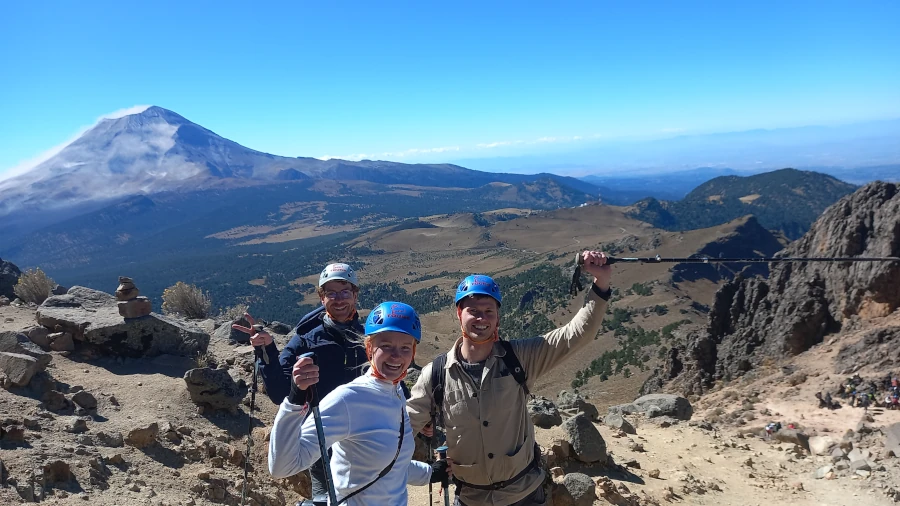Iztaccíhuatl, a majestic 5,230 m volcano in central Mexico, is both a symbol of mountaineering and a dream for hikers. Known as the “Sleeping Woman” for its silhouette, this giant of rock and ice attracts adventurers from around the world.
Reaching the summit is a demanding high-altitude climb—long hours, unpredictable weather, and the challenge of thin air. But not every hike on Iztaccíhuatl has to be extreme. There are also guided hiking routes at lower levels (3,600–4,500 m) where you can safely enjoy spectacular views of Popocatépetl and the national park.
In this guide we’ll explain the difficulty of the summit—fitness, acclimatization, equipment, and altitude risks—while also showing you the easier Iztaccíhuatl hikes available for beginners and intermediates. 👉 Learn more about our guided Iztaccíhuatl hikes.

Is it Difficult to Climb Iztaccíhuatl?
Yes, climbing to the summit of Iztaccíhuatl is a serious high-altitude challenge that demands preparation, fitness, and respect for nature. The ascent is generally recommended for people who already have experience in mountains above 4,000–4,500 m, since altitude is one of the biggest obstacles.
For most travelers, the best way to experience the volcano is through an Iztaccíhuatl hike at lower altitudes, where you can enjoy the scenery without the extreme challenge of the summit.
Key Facts about the Iztaccíhuatl Ascent:
⏳Total duration: 14 to 16 hours (round trip)
🔼Ascent: 8 to 9 hours of hiking
🔽Descent: 6 to 7 hours
📍Initial altitude: 3,970 masl (approximately)
⛰Maximum altitude: 5,230 masl (summit)
↔️Distance: ≈13.5 km (round trip)
❄Terrain: Rocky with slopes, glaciers, and snow (crampons and ice axe required)
🌡Climate: Cold, sub-zero temperatures at the summit, strong winds, and sudden changes (seasonally dependent)

How Long Does it Take to Climb Iztaccíhuatl?
The ascent and descent time depends on each person. The average ascent time is 8 to 9 hours, and the descent is 6 to 7 hours, depending on the pace, which determines everything. The important thing is to ascend slowly at a steady pace.
Who Can Climb Iztaccíhuatl?
Iztaccíhuatl is not for beginners. If you dream of conquering this volcano, prepare yourself with prior experience in high mountains. The challenge is worth it! While excellent physical condition is important, it’s not the only determining factor.
✅ This ascent is for you if:
- You have experience in high mountains above 4,000 or 4,500 masl.
- You are accustomed to long hikes in difficult, sloping terrain.
- You understand that altitude is an unpredictable factor, and you might not reach the summit.
- You exercise regularly (swimming, hiking, running, cycling).
- You are aware that the summit is not guaranteed, as various factors influence it, such as the climate and your health. Remember that safety comes first.
❌ This tour is NOT recommended if:
- This tour is NOT recommended if you have never been above 4,000–4,500 masl or if you’re looking for a short or moderate hike. Instead, consider our easier Iztaccíhuatl hiking routes designed for beginners and intermediates.
The Altitude Challenge
Altitude is sometimes a matter of luck and is one of the biggest obstacles when climbing to the summit of Iztaccíhuatl. Even if you have great physical condition, there’s no way to predict how your body will react; the only way to know is to go to the mountain.
As you ascend, the atmospheric pressure decreases, and the available oxygen reduces, and if your body is not sufficiently acclimatized and adapted to this altitude, you can experience Acute Mountain Sickness.
Common Symptoms of Mountain Sickness:
- Extreme fatigue
- Headache
- Nausea and vomiting
- Dizziness and vertigo
It’s essential to listen to your body and stop the ascent if you experience symptoms. Forcing the climb can have serious consequences.
If you want to enjoy Iztaccíhuatl without the risks of high altitude, there are guided hikes at lower levels (3,600–4,500 m). Our guided Iztaccíhuatl tours let you explore safely while still experiencing breathtaking views.
Recommendations
- Spend at least 3 days in Mexico City or Puebla. This will help your body begin to acclimate to the higher altitude.
- Camp at altitudes of 3,000 – 4,000m. This further aids in altitude acclimatization.
- Consult with your doctor if you can take any medication to counteract altitude sickness. Discuss potential options and any personal health considerations.
- If it is your first time on Iztaccíhuatl, or you do not have high altitude mountaineering experience, we recommend starting with level 1, level 2, or level 3. Explore the volcano’s foothills and admire its natural beauty on less demanding hikes. We offer various hiking routes that will allow you to enjoy the landscape and local flora:
- Level 1: Ideal for beginners and those who have never been above 4,000 meters (13,100 feet). This hike offers a beautiful walk between the two volcanoes, providing the best views of Popocatépetl and Iztaccíhuatl in the entire national park. The views of the Popocatepetl Volcano are even more impressive from this hike. Altitudes range between 3,600 and 3,980 meters (11,800 – 13,060 feet) above sea level.
- Level 2: This is a longer hike, also with excellent views of the volcanoes. Designed for intermediate athletes who exercise regularly. On this hike, you will be in direct contact with nature, walking among pine trees and alpine meadows, and listening to the relaxing sound of water from springs and waterfalls. Altitudes range between 3,600 and 3,950 meters (11,800 – 12,960 feet) above sea level.
- Level 3: Route to Los Portillos (4,000 – 4,500 meters / 13,100 – 14,760 feet above sea level). This is an exceptional adventure route that provides a truly otherworldly experience, evoking the sensation of being on Mars. It’s also an excellent opportunity to experience your body’s reaction to high altitude.
“Qué Loco Tours” offers options for all levels, from leisurely walks to demanding ascents. Check out our Iztaccíhuatl hiking tour options to find the perfect route for your level!

Necessary Equipment to Climb Iztaccíhuatl
Having the right equipment is essential to ensure your safety and comfort on the mountain.
Clothing:
- 3-layer system:
- 1st Layer (Base Layer): Moisture-wicking shirt (e.g., Dry-fit, merino wool). Its function is to keep sweat away from the skin.
- 2nd Layer (Insulating Layer): Fleece or down jacket/pullover. Its function is to retain body heat.
- 3rd Layer (Shell Layer): Waterproof and windproof jacket. Its function is to protect from the elements and allow for breathability.
- Mountain pants
- Gloves and hat
Footwear:
- Mid or high mountain boots
- Mountain socks
Technical Equipment:
- Crampons (properly fitted to your boots)
- Ice axe
- Climbing Helmet
- Climbing rope (if traveling in a group or on a technical route)
Others:
- Mountain backpack (appropriate size for the trip)
- Sleeping bag (rated for the expected temperatures)
- Water bottle or hydration system
- Energy food (bars, nuts, chocolate, trail mix)
- Sunglasses and high-SPF sunscreen
- Buff
- Headlamp
- First aid kit
- Map and compass or GPS device (and knowledge of how to use them)
Physical and Mental Preparation
Preparation for Iztaccíhuatl is not limited to equipment. It’s essential to be in good physical and mental shape.
- Training: Perform cardiovascular and strength exercise regularly.
- Acclimatization: If you live at a low altitude, spend time at intermediate altitudes before the ascent to allow your body to adjust.
- Rest: Get enough sleep and avoid stress before the expedition.
- Nutrition: Focus on consuming healthy foods, such as fruits, vegetables, pasta, and eggs, while avoiding high-fat meals in the days leading up to the hike. It is also advisable to avoid street food to reduce the risk of illness on the day of your excursion.
- Mentalization: Prepare to face challenges and overcome obstacles.

Hire a Professional Guide
If it’s your first time on Iztaccíhuatl or you don’t have experience in high altitude mountaineering, it’s highly recommended to hire a professional guide. A guide will provide you with safety, experience, and knowledge of the mountain.
For travelers not aiming for the summit, our guided Iztaccíhuatl hikes are the safest way to enjoy the volcano and learn from experienced local guides.
Book Your Iztaccíhuatl Adventure
Ready to conquer the ‘Sleeping Woman’? Don’t wait any longer! Plan your Iztaccíhuatl expedition with us and experience an unforgettable adventure. Reserve and secure your spot.
Whether you’re looking for the summit or an easier Iztaccíhuatl hike, our certified guides will help you enjoy the volcano safely and at your own pace.

Final Tips
- Respect nature: Leave no trace and follow the park rangers’ instructions. Know the CONANP code of conduct.
- Be aware of your limits: Safety comes first.
- Enjoy the experience: Iztaccíhuatl is a magical mountain that will leave you with unforgettable memories!
Dare to live the adventure and conquer Iztaccíhuatl!
FAQS
You need a good level of fitness for this climb. We recommend regular physical activity such as swimming, hiking with inclines, stair climbing, or training on a stair climber at the gym. Cardiovascular endurance and leg strength are essential for handling the high altitude and long ascent.
The best months to climb are from October to July, as these months generally have better weather conditions. It is possible to hike in August and September, but it depends on the rain. The rainiest month is September, which can make the ascent more challenging and risky.
No, we do not recommend it for beginners. This is a high-altitude climb that requires prior experience in mountains above 4,000 meters (13,100 feet). If you are new to mountaineering, we suggest starting with lower-altitude hikes before attempting Iztaccíhuatl.
Some risks include:
- Altitude sickness (Acute Mountain Sickness) due to low oxygen levels.
- Getting lost on the route if visibility is low.
- Rapid weather changes, including clouds, strong winds, and sudden cold temperatures.
- Slippery terrain, with loose rocks, ice, and sand that can make hiking dangerous.
Yes, technical equipment is required, especially in winter or for higher sections of the climb. Recommended gear includes crampons, an ice axe, a helmet, and proper mountaineering boots. Having the right equipment ensures safety and comfort.
Yes, hiring a professional guide is recommended, especially for first-time climbers. Guides help with navigation, safety, and acclimatization.
No, prior experience is necessary. The altitude, steep terrain, and potential weather changes make it a challenging climb. If you haven’t climbed a high-altitude mountain before, it’s best to start with lower-altitude hikes to prepare.
The total duration is between 14 to 16 hours round trip:
- Ascent: 8 to 9 hours
- Descent: 6 to 7 hours
The exact time depends on your pace, fitness level, and weather conditions.
The hike starts at 3,960 meters (12,990 feet) at La Joya, the most common starting point for the ascent to the summit.
No, reaching the summit is not the only option! There are several hiking routes at lower altitudes that offer breathtaking views of Iztaccíhuatl and Popocatépetl without the extreme challenge of a summit climb. These hikes range from beginner-friendly trails at 3,600m (11,800 ft) to moderate treks up to 4,500m (14,760 ft), allowing you to experience the beauty of the volcano at your own pace. 👉 Discover our guided Iztaccíhuatl hiking tours for safer, easier options.


